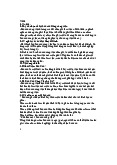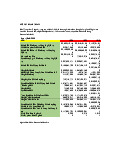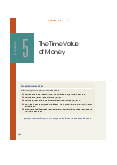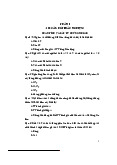



















Preview text:
Full file at http://testbankwizard.eu/Test-Bank-for-Principles-of-Corporate-Finance-10th-Edition-by-Brealey Chapter 02
How to Calculate Present Values Multiple Choice Questions
1. The present value of $100 expected in two years from today at a discount rate of 6% is: A. $116.64 B. $108.00 C. $100.00 D. $89.00
2. Present Value is defined as:
A. Future cash flows discounted to the present at an appropriate discount rate
B. Inverse of future cash flows
C. Present cash flow compounded into the future D. None of the above
3. If the interest rate is 12%, what is the 2-year discount factor? A. 0.7972 B. 0.8929 C. 1.2544 D. None of the above
4. If the present value of the cash flow X is $240, and the present value cash flow Y $160,
then the present value of the combined cash flow is: A. $240 B. $160 C. $80 D. $400 2-1
Full file at http://testbankwizard.eu/Test-Bank-for-Principles-of-Corporate-Finance-10th-Edition-by-Brealey
5. The rate of return is also called: I) discount rate; II) hurdle rate; III) opportunity cost of capital A. I only B. I and II only C. I, II, and III D. None of the given ones
6. Present value of $121,000 expected to be received one year from today at an interest rate
(discount rate) of 10% per year is: A. $121,000 B. $100,000 C. $110,000 D. None of the above
7. One year discount factor at a discount rate of 25% per year is: A. 1.25 B. 1.0 C. 0.8 D. None of the above
8. The one-year discount factor at an interest rate of 100% per year is: A. 1.5 B. 0.5 C. 0.25 D. None of the above
9. Present Value of $100,000 that is, expected, to be received at the end of one year at a
discount rate of 25% per year is: A. $80,000 B. $125,000 C. $100,000 D. None of the above 2-2
Full file at http://testbankwizard.eu/Test-Bank-for-Principles-of-Corporate-Finance-10th-Edition-by-Brealey
10. If the one-year discount factor is 0.8333, what is the discount rate (interest rate) per year? A. 10% B. 20% C. 30% D. None of the above
11. If the present value of $480 to be paid at the end of one year is $400, what is the one-year discount factor? A. 0.8333 B. 1.20 C. 0.20 D. None of the above
12. If the present value of $250 expected to be received one year from today is $200, what is the discount rate? A. 10% B. 20% C. 25% D. None of the above
13. If the one-year discount factor is 0.90, what is the present value of $120 to be received one year from today? A. $100 B. $96 C. $108 D. None of the above
14. If the present value of $600 expected to be received one year from today is $400, what is the one-year discount rate? A. 15% B. 20% C. 25% D. 50% 2-3
Full file at http://testbankwizard.eu/Test-Bank-for-Principles-of-Corporate-Finance-10th-Edition-by-Brealey
15. The present value formula for one period cash flow is: A. PV = C (1 + r) 1 B. PV = C /(1 + r) 1 C. PV = C1/r D. None of the above
16. The net present value formula for one period is: I) NPV = C + [C 0 /
1 (1 + r)]; II) NPV = PV required investment; and III) NPV = C0/C 1 A. I only B. I and II only C. III only D. None of the above
17. An initial investment of $400,000 will produce an end of year cash flow of $480,000.
What is the NPV of the project at a discount rate of 20%? A. $176,000 B. $80,000 C. $0 (zero) D. None of the above
18. If the present value of a cash flow generated by an initial investment of $200,000 is $250,000,
what is the NPV of the project? A. $250,000 B. $50,000 C. $200,000 D. None of the above 2-4
Full file at http://testbankwizard.eu/Test-Bank-for-Principles-of-Corporate-Finance-10th-Edition-by-Brealey
19. What is the present value of the following cash flow at a discount rate of 9%? A. $372,431.81 B. $450,000 C. $405,950.68 D. None of the above
20. At an interest rate of 10%, which of the following cash flows should you prefer? A. Option A B. Option B C. Option C D. Option D
21. What is the net present value of the following cash flow at a discount rate of 11%? A. $69,108.03 B. $231,432.51 C. $80,000 D. None of the above
22. What is the present value of the following cash flow at a discount rate of 16% APR? A. $136,741.97 B. $122,948.87 C. $158,620.69 D. None of the above 2-5
Full file at http://testbankwizard.eu/Test-Bank-for-Principles-of-Corporate-Finance-10th-Edition-by-Brealey
23. What is the net present value (NPV) of the following cash flows at a discount rate of 9%? A. $122,431.81 B. $200,000 C. $155,950.68 D. None of the above
24. The following statements regarding the NPV rule and the rate of return rule are true except:
A. Accept a project if its NPV > 0
B. Reject a project if the NPV < 0
C. Accept a project if its rate of return > 0
D. Accept a project if its rate of return > opportunity cost of capital
25. An initial investment of $500 produces a cash flow $550 one year from today. Calculate
the rate of return on the project A. 10% B. 15% C. 25% D. none of the above
26. According to the net present value rule, an investment in a project should be made if the:
A. Net present value is greater than the cost of investment
B. Net present value is greater than the present value of cash flows
C. Net present value is positive
D. Net present value is negative 2-6
Full file at http://testbankwizard.eu/Test-Bank-for-Principles-of-Corporate-Finance-10th-Edition-by-Brealey
27. Which of the following statements regarding the net present value rule and the rate of return rule is not true?
A. Accept a project if NPV > cost of investment
B. Accept a project if NPV is positive
C. Accept a project if return on investment exceeds the rate of return on an equivalent
investment in the financial market
D. Reject a project if NPV is negative
28. The opportunity cost of capital for a risky project is
A. The expected rate of return on a government security having the same maturity as the project
B. The expected rate of return on a well-diversified portfolio of common stocks
C. The expected rate of return on a portfolio of securities of similar risks as the project D. None of the above
29. A perpetuity is defined as:
A. Equal cash flows at equal intervals of time for a specific number of periods
B. Equal cash flows at equal intervals of time forever
C. Unequal cash flows at equal intervals of time forever D. None of the above
30. Which of the following is generally considered an example of a perpetuity:
A. Interest payments on a 10-year bond
B. Interest payments on a 30-year bond C. Consols D. None of the above 2-7
Full file at http://testbankwizard.eu/Test-Bank-for-Principles-of-Corporate-Finance-10th-Edition-by-Brealey
31. You would like to have enough money saved to receive $100,000 per year perpetuity after
retirement so that you and your family can lead a good life. How much would you need to
save in your retirement fund to achieve this goal (assume that the perpetuity payments start
one year from the date of your retirement. The interest rate is 12.5%)? A. $1,000,000 B. $10,000,000 C. $800,000 D. None of the above
32. What is the present value of $10,000 per year perpetuity at an interest rate of 10%? A. $10,000 B. $100,000 C. $200,000 D. None of the above
33. You would like to have enough money saved to receive $80,000 per year perpetuity after
retirement so that you and your family can lead a good life. How much would you need to
save in your retirement fund to achieve this goal (assume that the perpetuity payments start
one year from the date of your retirement. The interest rate is 8%)? A. $7,500,000 B. $750,000 C. $1,000,000 D. None of the above
34. You would like to have enough money saved to receive a $50,000 per year perpetuity after
retirement so that you and your family can lead a good life. How much would you need to
save in your retirement fund to achieve this goal (assume that the perpetuity payments starts
on the day of retirement. The interest rate is 8%)? A. $1,000,000 B. $675,000 C. $625,000 D. None of the above 2-8
Full file at http://testbankwizard.eu/Test-Bank-for-Principles-of-Corporate-Finance-10th-Edition-by-Brealey
35. You would like to have enough money saved to receive an $80,000 per year perpetuity
after retirement so that you and your family can lead a good life. How much would you need
to save in your retirement fund to achieve this goal (assume that the perpetuity payments
starts on the day of retirement. The interest rate is 10%)? A. $1,500,000 B. $880,000 C. $800,000 D. None of the above 36. An annuity is defined as
A. Equal cash flows at equal intervals of time for a specified period of time
B. Equal cash flows at equal intervals of time forever
C. Unequal cash flows at equal intervals of time forever D. None of the above
37. If you receive $1,000 payment at the end each year for the next five years, what type of cash flow do you have? A. Uneven cash flow stream B. An annuity C. An annuity due D. None of the above
38. If the three-year present value annuity factor is 2.673 and two-year present value annuity
factor is 1.833, what is the present value of $1 received at the end of the 3 years? A. $1.1905 B. $0.84 C. $0.89 D. None of the above 2-9
Full file at http://testbankwizard.eu/Test-Bank-for-Principles-of-Corporate-Finance-10th-Edition-by-Brealey
39. If the five-year present value annuity factor is 3.60478 and four-year present value annuity
factor is 3.03735, what is the present value at the $1 received at the end of five years? A. $0.63552 B. $1.76233 C. $0.56743 D. None of the above
40. What is the present value annuity factor at a discount rate of 11% for 8 years? A. 5.7122 B. 11.8594 C. 5.1461 D. None of the above
41. What is the present value annuity factor at an interest rate of 9% for 6 years? A. 7.5233 B. 4.4859 C. 1.6771 D. None of the above
42. What is the present value of $1000 per year annuity for five years at an interest rate of 12%? A. $6,352.85 B. $3,604.78 C. $567.43 D. None of the above
43. What is the present value of $5000 per year annuity at a discount rate of 10% for 6 years? A. $21,776.30 B. $3,371.91 C. $16,760.78 D. None of the above 2-10




